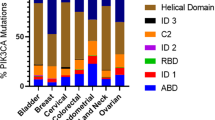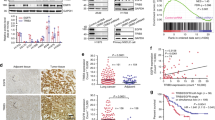Abstract
PI3-kinase has a crucial role in transformation mediated by the oncogenic c-Kit mutant D816V. In this study, we demonstrate that the c-Kit/D816V-mediated cell survival is dependent on an intact direct binding of PI3-kinase to c-Kit. However, mutation of this binding site had little effect on the PI3-kinase activity in the cells, suggesting that c-Kit/D816V-mediated cell survival is dependent on PI3-kinase but not its kinase activity. Furthermore, inhibition of the lipid kinase activity of PI3-kinase led only to a slight inhibition of cell survival. Knockdown of the predominant PI3-kinase isoform p110δ in c-Kit/D816V-expressing Ba/F3 cells led to reduced cell transformation both in vitro and in vivo without affecting the overall PI3-kinase activity. This suggests that p110δ has a lipid-kinase-independent role in c-Kit/D816V-mediated cell transformation. We furthermore demonstrate that p110δ is phosphorylated at residues Y524 and S1039 and that phosphorylation requires an intact binding site for PI3-kinase in c-Kit/D816V. Overexpression of p110δ carrying the Y523F and S1038A mutations significantly reduced c-Kit/D816V-mediated cell survival and proliferation. Taken together, our results demonstrate an important lipid-kinase-independent role of p110δ in c-Kit/D816V-mediated cell transformation. This furthermore suggests that p110δ could be a potential diagnostic factor and selective therapeutic target for c-Kit/D816V-expressing malignancies.
This is a preview of subscription content, access via your institution
Access options
Subscribe to this journal
Receive 50 print issues and online access
$259.00 per year
only $5.18 per issue
Buy this article
- Purchase on Springer Link
- Instant access to full article PDF
Prices may be subject to local taxes which are calculated during checkout





Similar content being viewed by others
References
Lennartsson J, Rönnstrand L . Stem cell factor receptor/c-Kit: from basic science to clinical implications. Physiol Rev 2012; 92: 1619–1649.
Serve H, Yee NS, Stella G, Sepp-Lorenzino L, Tan JC, Besmer P . Differential roles of PI3-kinase and Kit tyrosine 821 in Kit receptor-mediated proliferation, survival and cell adhesion in mast cells. EMBO J 1995; 14: 473–483.
Jia S, Roberts TM, Zhao JJ . Should individual PI3 kinase isoforms be targeted in cancer? Curr Opin Cell Biol 2009; 21: 199–208.
Vanhaesebroeck B, Welham MJ, Kotani K, Stein R, Warne PH, Zvelebil MJ et al. P110delta, a novel phosphoinositide 3-kinase in leukocytes. Proc Natl Acad Sci USA 1997; 94: 4330–4335.
Eickholt BJ, Ahmed AI, Davies M, Papakonstanti EA, Pearce W, Starkey ML et al. Control of axonal growth and regeneration of sensory neurons by the p110delta PI 3-kinase. PLoS One 2007; 2: e869.
Sawyer C, Sturge J, Bennett DC, O'Hare MJ, Allen WE, Bain J et al. Regulation of breast cancer cell chemotaxis by the phosphoinositide 3-kinase p110delta. Cancer Res 2003; 63: 1667–1675.
Arcaro A, Khanzada UK, Vanhaesebroeck B, Tetley TD, Waterfield MD, Seckl MJ . Two distinct phosphoinositide 3-kinases mediate polypeptide growth factor-stimulated PKB activation. EMBO J 2002; 21: 5097–5108.
Boller D, Schramm A, Doepfner KT, Shalaby T, von Bueren AO, Eggert A et al. Targeting the phosphoinositide 3-kinase isoform p110delta impairs growth and survival in neuroblastoma cells. Clin Cancer Res 2008; 14: 1172–1181.
Stoyanov B, Volinia S, Hanck T, Rubio I, Loubtchenkov M, Malek D et al. Cloning and characterization of a G protein-activated human phosphoinositide-3 kinase. Science 1995; 269: 690–693.
Ning ZQ, Li J, Arceci RJ . Activating mutations of c-kit at codon 816 confer drug resistance in human leukemia cells. Leuk Lymphoma 2001; 41: 513–522.
Beghini A, Peterlongo P, Ripamonti CB, Larizza L, Cairoli R, Morra E et al. C-kit mutations in core binding factor leukemias. Blood 2000; 95: 726–727.
Tian Q, Frierson HF Jr, Krystal GW, Moskaluk CA . Activating c-kit gene mutations in human germ cell tumors. Am J Pathol 1999; 154: 1643–1647.
Longley BJ, Tyrrell L, Lu SZ, Ma YS, Langley K, Ding TG et al. Somatic c-KIT activating mutation in urticaria pigmentosa and aggressive mastocytosis: establishment of clonality in a human mast cell neoplasm. Nat Genet 1996; 12: 312–314.
Sakuma Y, Sakurai S, Oguni S, Satoh M, Hironaka M, Saito K . c-kit gene mutations in intracranial germinomas. Cancer Sci 2004; 95: 716–720.
Hongyo T, Li T, Syaifudin M, Baskar R, Ikeda H, Kanakura Y et al. Specific c-kit mutations in sinonasal natural killer/T-cell lymphoma in China and Japan. Cancer Res 2000; 60: 2345–2347.
Orfao A, Garcia-Montero AC, Sanchez L, Escribano L . Recent advances in the understanding of mastocytosis: the role of KIT mutations. Br J Haematol 2007; 138: 12–30.
Schittenhelm MM, Shiraga S, Schroeder A, Corbin AS, Griffith D, Lee FY et al. Dasatinib (BMS-354825), a dual SRC/ABL kinase inhibitor, inhibits the kinase activity of wild-type, juxtamembrane, and activation loop mutant KIT isoforms associated with human malignancies. Cancer Res 2006; 66: 473–481.
Hantschel O, Rix U, Superti-Furga G . Target spectrum of the BCR-ABL inhibitors imatinib, nilotinib and dasatinib. Leuk Lymphoma 2008; 49: 615–619.
Hashimoto K, Matsumura I, Tsujimura T, Kim DK, Ogihara H, Ikeda H et al. Necessity of tyrosine 719 and phosphatidylinositol 3'-kinase-mediated signal pathway in constitutive activation and oncogenic potential of c-kit receptor tyrosine kinase with the Asp814Val mutation. Blood 2003; 101: 1094–1102.
Backer JM, Myers MG Jr, Shoelson SE, Chin DJ, Sun XJ, Miralpeix M et al. Phosphatidylinositol 3'-kinase is activated by association with IRS-1 during insulin stimulation. EMBO J 1992; 11: 3469–3479.
Sun J, Pedersen M, Rönnstrand L . Gab2 is involved in differential phosphoinositide 3-kinase signaling by two splice forms of c-Kit. J Biol Chem 2008; 283: 27444–27451.
Sun J, Pedersen M, Rönnstrand L . The D816V mutation of c-Kit circumvents a requirement for Src family kinases in c-Kit signal transduction. J Biol Chem 2009; 284: 11039–11047.
Longley BJ Jr, Metcalfe DD, Tharp M, Wang X, Tyrrell L, Lu SZ et al. Activating and dominant inactivating c-KIT catalytic domain mutations in distinct clinical forms of human mastocytosis. Proc Natl Acad Sci USA 1999; 96: 1609–1614.
Pardanani A . Systemic mastocytosis in adults: 2012 Update on diagnosis, risk stratification, and management. Am J Hematol 2012; 87: 401–411.
Chian R, Young S, Danilkovitch-Miagkova A, Rönnstrand L, Leonard E, Ferrao P et al. Phosphatidylinositol 3 kinase contributes to the transformation of hematopoietic cells by the D816V c-Kit mutant. Blood 2001; 98: 1365–1373.
Harir N, Boudot C, Friedbichler K, Sonneck K, Kondo R, Martin-Lannerée S et al. Oncogenic kit controls neoplastic mast cell growth through a Stat5/PI3-kinase signaling cascade. Blood 2008; 112: 2463–2473.
Ogita S, Lorusso P . Targeting phosphatidylinositol 3 kinase (PI3K)-Akt beyond rapalogs. Target Oncol 2011; 6: 103–117.
Miller TW, Rexer BN, Garrett JT, Arteaga CL . Mutations in the phosphatidylinositol 3-kinase pathway: role in tumor progression and therapeutic implications in breast cancer. Breast Cancer Res 2011; 13: 224.
Cornillet-Lefebvre P, Cuccuini W, Bardet V, Tamburini J, Gillot L, Ifrah N et al. Constitutive phosphoinositide 3-kinase activation in acute myeloid leukemia is not due to p110delta mutations. Leukemia 2006; 20: 374–376.
Czupalla C, Culo M, Müller EC, Brock C, Reusch HP, Spicher K et al. Identification and characterization of the autophosphorylation sites of phosphoinositide 3-kinase isoforms beta and gamma. J Biol Chem 2003; 278: 11536–11545.
Vanhaesebroeck B, Higashi K, Raven C, Welham M, Anderson S, Brennan P et al. Autophosphorylation of p110delta phosphoinositide 3-kinase: a new paradigm for the regulation of lipid kinases in vitro and in vivo. EMBO J 1999; 18: 1292–1302.
Corless CL, Barnett CM, Heinrich MC . Gastrointestinal stromal tumours: origin and molecular oncology. Nat Rev Cancer 2011; 11: 865–878.
Mol CD, Dougan DR, Schneider TR, Skene RJ, Kraus ML, Scheibe DN et al. Structural basis for the autoinhibition and STI-571 inhibition of c-Kit tyrosine kinase. J Biol Chem 2004; 279: 31655–31663.
Sadrzadeh H, Abdel-Wahab O, Fathi AT . Molecular alterations underlying eosinophilic and mast cell malignancies. Discov Med 2011; 12: 481–493.
Boissel N, Leroy H, Brethon B, Philippe N, de Botton S, Auvrignon A et al. Incidence and prognostic impact of c-Kit, FLT3, and Ras gene mutations in core binding factor acute myeloid leukemia (CBF-AML). Leukemia 2006; 20: 965–970.
Aichberger KJ, Sperr WR, Gleixner KV, Kretschmer A, Valent P . Treatment responses to cladribine and dasatinib in rapidly progressing aggressive mastocytosis. Eur J Clin Invest 2008; 38: 869–873.
Verstovsek S, Tefferi A, Cortes J, O'Brien S, Garcia-Manero G, Pardanani A et al. Phase II study of dasatinib in Philadelphia chromosome-negative acute and chronic myeloid diseases, including systemic mastocytosis. Clin Cancer Res 2008; 14: 3906–3915.
Cohen SM, Mukerji R, Timmermann BN, Samadi AK, Cohen MS . A novel combination of withaferin A and sorafenib shows synergistic efficacy against both papillary and anaplastic thyroid cancers. Am J Surg 2012; 204: 895–901.
Nijenhuis CM, Haanen JB, Schellens JH, Beijnen JH . Is combination therapy the next step to overcome resistance and reduce toxicities in melanoma? Cancer Treat Rev 2013; 39: 305–312.
Blume-Jensen P, Siegbahn A, Stabel S, Heldin CH, Rönnstrand L . Increased Kit/SCF receptor induced mitogenicity but abolished cell motility after inhibition of protein kinase C. EMBO J 1993; 12: 4199–4209.
Lundby A, Olsen JV . GeLCMS for in-depth protein characterization and advanced analysis of proteomes. Methods Mol Biol 2011; 753: 143–155.
Olsen JV, Schwartz JC, Griep-Raming J, Nielsen ML, Damoc E, Denisov E et al. A dual pressure linear ion trap Orbitrap instrument with very high sequencing speed. Mol Cell Proteomics 2009; 8: 2759–2769.
Cox J, Matic I, Hilger M, Nagaraj N, Selbach M, Olsen JV et al. A practical guide to the MaxQuant computational platform for SILAC-based quantitative proteomics. Nat Protoc 2009; 4: 698–705.
Acknowledgements
This research was supported by grants from the Swedish Cancer Society, the Swedish Research Council, the Strategic Cancer Research Program at Lund University, BioCARE, ALF governmental clinical grant, Stiftelsen Olle Engkvist Byggmästare, Alfred Österlund Foundation, Gunnar Nilsson Cancer Society and MAS Cancer Foundation.
Author information
Authors and Affiliations
Corresponding author
Ethics declarations
Competing interests
The authors declare no conflict of interest.
Additional information
Supplementary Information accompanies this paper on the Oncogene website
Supplementary information
Rights and permissions
About this article
Cite this article
Sun, J., Mohlin, S., Lundby, A. et al. The PI3-kinase isoform p110δ is essential for cell transformation induced by the D816V mutant of c-Kit in a lipid-kinase-independent manner. Oncogene 33, 5360–5369 (2014). https://doi.org/10.1038/onc.2013.479
Received:
Revised:
Accepted:
Published:
Issue Date:
DOI: https://doi.org/10.1038/onc.2013.479
Keywords
This article is cited by
-
Loss of PI3 kinase association improves the sensitivity of secondary mutation of KIT to Imatinib
Cell & Bioscience (2020)
-
XK-related protein 5 (XKR5) is a novel negative regulator of KIT/D816V-mediated transformation
Oncogenesis (2018)
-
Bruton’s tyrosine kinase potentiates ALK signaling and serves as a potential therapeutic target of neuroblastoma
Oncogene (2018)
-
Germline mutations of KIT in gastrointestinal stromal tumor (GIST) and mastocytosis
Cell & Bioscience (2016)
-
Aberrant activation of the PI3K/mTOR pathway promotes resistance to sorafenib in AML
Oncogene (2016)



